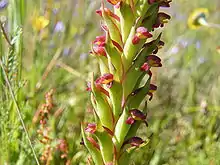Disa bracteata
Disa bracteata, also known as the bract disa, leek orchid or the South African weed orchid is a species of orchid native to South Africa.[2]
| Disa bracteata | |
|---|---|
 | |
| Scientific classification | |
| Kingdom: | Plantae |
| Clade: | Tracheophytes |
| Clade: | Angiosperms |
| Clade: | Monocots |
| Order: | Asparagales |
| Family: | Orchidaceae |
| Subfamily: | Orchidoideae |
| Genus: | Disa |
| Species: | D. bracteata |
| Binomial name | |
| Disa bracteata | |
| Synonyms[1] | |
Description
This tuberous geophyte that typically grows up to 30 cm (12 in) tall, although there are records of taller specimens.[3] The linear-lanceolate leaves are 4–12 cm (1.6–4.7 in) long.[4] They have a rounded base and sharply pointed tips.[5]
Flowers are present between September and November.[3] They grow in a many flowered cylindrical inflorescence that is 2–12 cm (0.79–4.72 in) long. The bracts are slightly longer than the flowers themselves. The flowers are bi-coloured with greenish-yellow lower sections and helmet-shaped maroon upper sections.[5] The helmet-shaped sepals are 2.5–4.5 mm (0.098–0.177 in) long. The shallowly triangular spur is 3–4.5 mm (0.12–0.18 in) long. The pendent lip has an oblong to oblanceolate shape. The anther is also pendent and has a large notch in the rostellum.[4]
Distribution and habitat
This species is endemic to South Africa, where it is found in the Western Cape and Eastern Cape.[3] It is found from sea level to an altitude of 2,000 m (6,600 ft) in Fynbos, Renosterveld and Albany Thicket habitats. It does particularly well in disturbed habitats, such as roadsides, where it is more common and occurs in higher densities than in undisturbed sites.[4]
Disa bracteata is invasive in Australia.[6] It is one of the few orchid species which has become naturalized in Australia.[7] It was first recorded in Western Australia in 1944, in South Australia in 1988 and Victoria in 1994. There is also a single recording in Tasmania.[2] In sites where D. bracteata has invaded, there have been up to 80 individuals found per square meter of the area. The similarity of environmental conditions in Australia and South Africa have allowed D. bracteata, as well as many other species native to South Africa, to become naturalized in regions of Australia.[8]
Conservation
This species is considered to be of least concern by the South African National Biodiversity Institute (SANBI).[10]
References
- "Disa bracteata". Global Biodiversity Information Facility. Retrieved 26 September 2023.
- "A weed in waiting". Introduced Plants & Animals of Victoria. Viridans. Retrieved 2009-09-07.
- Manning, John; Goldblatt, Peter (2012). Plants of the Greater Cape Floristic Region : 1: the core Cape flora (PDF). Pretoria: South African National Biodiversity Institute, SANBI. ISBN 978-1-919976-74-7. OCLC 852384288.
- e-Flora of South Africa. v1.42. 2023. South African National Biodiversity Institute. http://ipt.sanbi.org.za/iptsanbi/resource?r=flora_descriptions&v=1.42
- Clarke, Hugh G.; Merry, Corinne (2019). Wild flowers of the Cape Peninsula (3rd ed.). Cape Town: Struik Nature. ISBN 978-1-77584-640-6. OCLC 1124073483.
- "South African weed orchid". Victorian Resources Online. Retrieved 2019-10-29.
- Clements, Mark; Jones, David (13 June 2008). "Australian Orchidaceae: Current Genera and species list". Retrieved 24 September 2013.
- Konowalik, Kamil; Kolanowska, Marta (2018-12-20). "Climatic niche shift and possible future spread of the invasive South African Orchid Disa bracteata in Australia and adjacent areas". PeerJ. 6: e6107. doi:10.7717/peerj.6107. ISSN 2167-8359. PMC 6304271. PMID 30595982.
- Johnson, S. D.; Linder, H. P.; Steiner, K. E. (1998). "Phylogeny and Radiation of Pollination Systems in Disa (Orchidaceae)". American Journal of Botany. 85 (3): 402–411. doi:10.2307/2446333. ISSN 0002-9122.
- Foden, W.; Potter, L. (2005). "Disa bracteata Sw. National Assessment: Red List of South African Plants version 2020.1". SANBI Red List of South African Plants. Retrieved 26 September 2023.
External links
 Media related to Disa bracteata at Wikimedia Commons
Media related to Disa bracteata at Wikimedia Commons Data related to Disa bracteata at Wikispecies
Data related to Disa bracteata at Wikispecies